A few blocks from the Cultural District, a late-1920s siren song beckons to those attuned to bohemian frequencies. It plays from the rock-walled courtyard and graceful iron archways of a Depression-era apartment complex called the Dorothy Lane Courts. Begun with a radio romance and built with radio money, it has long attracted gifted and eccentric characters. After almost 80 years, the Dorothy Lane is also a Fort Worth character in its own right.
 Built for an elegant, irrepressible woman and her enterprising husband, the rambling brick complex, faintly English in design, is a village-like enclave with its own eyebrow-raising folklore — of a ghost and a gambling den, secret rooms and speakeasy goings-on. A ceramic iguana in the courtyard honors a four-foot-long pet that lived there for a decade. Someday, another memorial might mark the short-term tenancy of two emerging comedians who sat around in skivvies working on their dialogues before motoring west to national fame.
Built for an elegant, irrepressible woman and her enterprising husband, the rambling brick complex, faintly English in design, is a village-like enclave with its own eyebrow-raising folklore — of a ghost and a gambling den, secret rooms and speakeasy goings-on. A ceramic iguana in the courtyard honors a four-foot-long pet that lived there for a decade. Someday, another memorial might mark the short-term tenancy of two emerging comedians who sat around in skivvies working on their dialogues before motoring west to national fame.
Tucked in amid the single-family homes of Arlington Heights, the Dorothy Lane has provided lodging for dancers and “business girls,” medical students, musicians, a poet or two, and people from enough faraway places that someone suggested the exterior should be adorned with international flags. Like the couple who created it, the complex has seen high times and hard times and has taken dips and turns such as Pearl Slaughter might have made, dancing at one of her own parties.
Wyatt William Slaughter got here first. Various records reveal that he was the son of a dry goods merchant and grandson of a botanical doctor in Arkansas. By 1918 he was in Dallas, clerking for a power company and registering for the draft. Family members are uncertain about his military service during the Great War, but five years after it ended, he moved to Fort Worth and went into business with an oilman who had money to invest. The Shield Company evolved as a wholesale and distribution outfit, specializing in Crosley radios, home appliances, and furniture. Radio was the ultimate home entertainment medium then, and Crosleys sold well.
Wyatt had plenty of money but too much solitude. So according to nephew Wyatt Webb, he placed a radio advertisement seeking a wife.
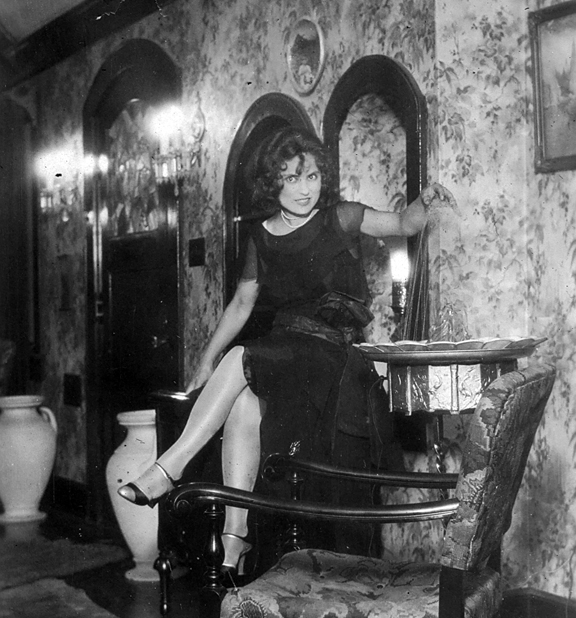 Clora Pearl Webb was born in Indian Territory and raised on a farm in East Texas. When census takers came around in 1910, her father listed 11-year-old Pearl as a farm laborer. She had metropolitan dreams, though, and quit the farm; by 1920, she was boarding at the Sulphur Springs home of a seamstress. Wherever she was when she heard the ad, she apparently never looked back. Thanks to the magic of radio, Wyatt had found his Pearl.
Clora Pearl Webb was born in Indian Territory and raised on a farm in East Texas. When census takers came around in 1910, her father listed 11-year-old Pearl as a farm laborer. She had metropolitan dreams, though, and quit the farm; by 1920, she was boarding at the Sulphur Springs home of a seamstress. Wherever she was when she heard the ad, she apparently never looked back. Thanks to the magic of radio, Wyatt had found his Pearl.
They married, traveled, and bought property in Arlington Heights. Dark-haired Pearl loved to dress up and vamp for the camera, petite beside her tall and stout sweetheart. By around 1928, she was planning a home, poring over House Beautiful, and sketching her ideas for extravagant extras. The result was a brick cottage that eventually included a solarium embellished with art tile and a nearly 40-foot-long salon with a stage at one end and a life-size portrait of Pearl on a side wall.
Some of the house’s features suggest that the Slaughters may have run a little in-home speakeasy during the late Prohibition years. A speaking tube ran from the solarium door to the basement, which also held a concealed walk-in safe and several compartments that locked from the inside. Wyatt Webb said that his cousins once found $13,000 hidden in slots in the house’s window frames.
Not long after they moved in, the Slaughters decided to add a maid’s quarters — two rooms and a bath over a garage. But as journalist Maude West Thompson recounted in her Dallas-based real estate journal, before a domestic servant could move in, “… two business girls saw it and made [Pearl] a substantial offer if she would rent it to them. This unexpected income spurred her to start a project which has resulted in the beautiful Dorothy Lane Courts … renting from $45 to $110 a month.”
Thompson devoted the cover and center spread of her magazine’s November/December 1937 issue to the 49-unit complex, whose architecture generally matched that of the house. All furnishings came from the Shield Company, including, as an ad proclaimed, a Crosley Shelvador, the latest in refrigerators, in each apartment. A later tenant noted that each apartment has some unique feature — no cookie-cutters at the Dorothy Lane.
An income-producing property wasn’t a bad idea in the opening years of the Depression, and the Slaughters added a second three-story building in 1932. Next came a swimming pool; its excavation yielded enough stones to make a walled commons for residents.
After that, in 1936, came another row of apartments facing southwest along Bertrose Avenue, probably built in anticipation of the Texas Centennial celebration. According to rumors that tend to swirl around the property, dancers in Billy Rose’s famed revue rented units, and matinee idol Clark Gable also stayed there.
 The Slaughters put together a small real estate empire. In 1940 they built the Colonial Hotel and Apartments (with coffee shop, tea garden, and liquor store) at Camp Bowie Boulevard and Montgomery Street and then bought a 1903 home adjacent to their own to divide into more rental units. Later Pearl would also own the Camp Bowie Bargain Center and open the Homestead Maternity Home on Crescent Street, overlooking West Vickery Boulevard.
The Slaughters put together a small real estate empire. In 1940 they built the Colonial Hotel and Apartments (with coffee shop, tea garden, and liquor store) at Camp Bowie Boulevard and Montgomery Street and then bought a 1903 home adjacent to their own to divide into more rental units. Later Pearl would also own the Camp Bowie Bargain Center and open the Homestead Maternity Home on Crescent Street, overlooking West Vickery Boulevard.
Family played a role in the enterprises. Pearl’s younger brother, Eugene Webb, and his wife managed the hotel coffee shop, and other relatives came to live at the Dorothy Lane. Then in 1945, Wyatt and Pearl adopted two infants. Born about a month apart, Gloria Pearl Slaughter Jr. and Wyatt William Slaughter II were raised as fraternal twins.
In flush times, Wyatt and Pearl belonged to a local country club and boat club. They owned two Cadillacs and an elaborate party boat, employed a porter and a maid, and bought peacocks that fanned their plumage in the courtyard. Family photos show the children at their country house in Montague County. In hard times, the Slaughters paid their attorney with furniture.
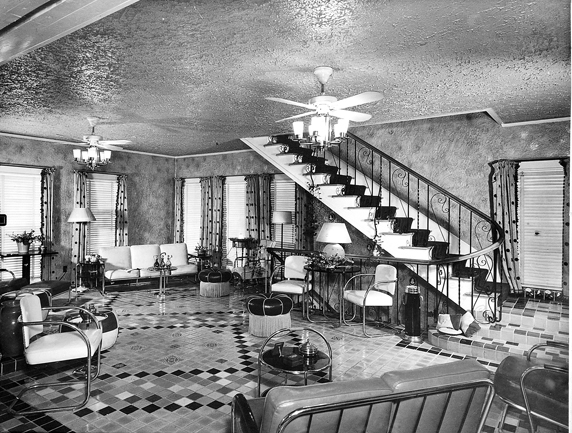 Wyatt died in 1955, and Pearl took over as president of The Shield Company. Eventually she became, as her nephew put it, “property poor,” and tax burdens forced her to sell some holdings.
Wyatt died in 1955, and Pearl took over as president of The Shield Company. Eventually she became, as her nephew put it, “property poor,” and tax burdens forced her to sell some holdings.
Radio, that medium so significant to the Slaughters, also drew two young hipsters to the Dorothy Lane in 1959. New KXOL-AM announcer George Carlin rented Apartment S. He had lost his job at Boston’s WEZE-AM after driving a news van to New York in search of marijuana. His former colleague and Boston roommate, Jack Burns, hired on at the station as a newsman soon afterward and shared digs with Carlin.
In those days, Carlin spun platters during the “homework shift,” reaching lots of kids with his eccentric turntable-side manner. He later told James Lipton on Inside the Actors Studio that it was “the best radio job I ever had.” He emceed sock hops and other events and, as he wrote later, saw firsthand the Fort Worth version of the cultural rebellion that was sweeping through the ranks of young people around the country.
Bedford native Frank Giles remembers listening to Carlin in those days. “When he became famous, I recognized [his] on-air character from KXOL — Al Sleet, the Hippy-Dippie Weatherman, and his insane, drug-crazed forecasts.”
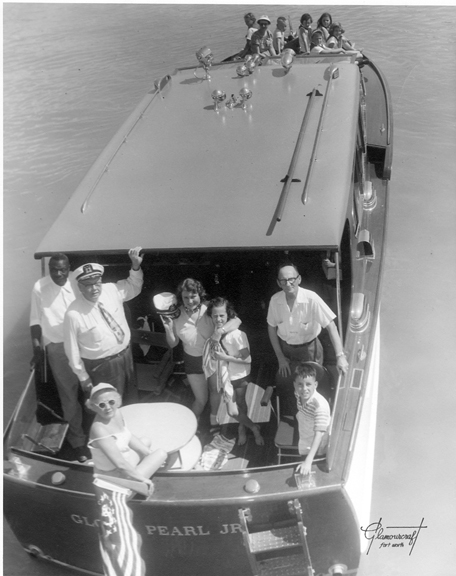 “Something else happened during that period that had a nice wistful, romantic flavor,” Carlin recalled in his memoir, Last Words. “We would watch The Jack Parr Show (‘where dreams are made’) and be full of fantasies about appearing on it. We’d sit around in our underwear — it was very hot in Texas, so we’d always be sitting around in our underwear — and improv getting on Parr.” Pearl Slaughter’s framed list of 21 tenant rules hung in every Dorothy Lane unit, but none of them prohibited lounging half-dressed or practicing blue jokes.
“Something else happened during that period that had a nice wistful, romantic flavor,” Carlin recalled in his memoir, Last Words. “We would watch The Jack Parr Show (‘where dreams are made’) and be full of fantasies about appearing on it. We’d sit around in our underwear — it was very hot in Texas, so we’d always be sitting around in our underwear — and improv getting on Parr.” Pearl Slaughter’s framed list of 21 tenant rules hung in every Dorothy Lane unit, but none of them prohibited lounging half-dressed or practicing blue jokes.
Carlin and Burns performed standup comedy together for the first time at The Cellar, Fort Worth’s beat mecca. They left the Dorothy Lane and Fort Worth in February 1960, heading for California. Burns performed in Second City productions, teamed with Avery Schreiber, worked with the Muppets, replaced Barney Fife on The Andy Griffith Show, voiced animated characters, and more. Carlin performed on television, in film, in print, on stage (including Fort Worth’s Bass Hall) and, posthumously, received the Kennedy Center’s Mark Twain prize.
Biographer James Sullivan mentioned the Dorothy Lane by name in 7 Dirty Words: The Life and Crimes of George Carlin. After the comedian’s death in 2008, two fans approached current owner Ann Stahl to ask her to create a George Carlin Memorial Park on the triangle of turf between the main Dorothy Lane complex and the Bertrose apartments. She’s still thinking about it.
As Carlin’s and Burns’ fortunes rose in the 1960s, the Dorothy Lane’s seemed to decline. Wallace Hutchison, who grew up in nearby Monticello, recalled walking past the Dorothy Lane one summer evening in the 1960s or 1970s and seeing the police kick in the door of a ground-floor apartment. “I always heard it wasn’t a very nice place to live,” he said.
Pearl died in 1974. She told her children never to tear down the house. Gloria and Wyatt II did not directly oversee their inherited complex; instead, they retained a longtime resident manager. Other owners would usher in a new era.
Peter and Ann Stahl arrived in Tarrant County in 1977 from Nebraska. He came to start a Texas branch of the Martin K. Eby Construction Co.; she worked part-time as nurse and health teacher at a Catholic school. They lived in North Richland Hills.
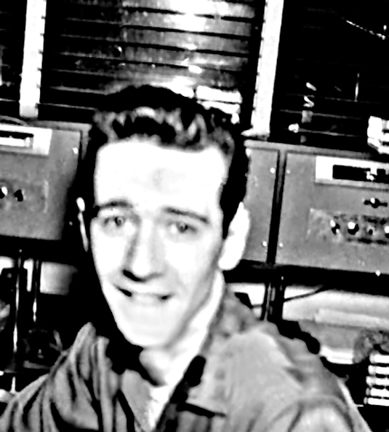 Ann was driving their daughter to preschool music lessons in Arlington Heights one day in 1982 when she decided to follow a different route. She saw the Dorothy Lane Courts for the first time, with a for-sale sign.
Ann was driving their daughter to preschool music lessons in Arlington Heights one day in 1982 when she decided to follow a different route. She saw the Dorothy Lane Courts for the first time, with a for-sale sign.
The couple bought the property (except the Bertrose buildings, now owned by Brett and Mike Thomas) that year and moved into the home. To clear it out for the new owners, Gloria conducted a huge estate sale of family possessions and apartment furnishings. Bidders competed for a half-circle marble bar, Murphy beds, a Charlie McCarthy puppet, a zither, smoking stands, movie star photos, costume jewelry, and more. Though the Slaughter siblings carried the note on the property for several years, their family’s era essentially ended with the last “sold!” pronouncement. Gloria died in 1996, Wyatt II in 2002.
Legends lingered after the sales. Over the years, the Stahls heard of gambling, a still, prostitution. A couple of former employees stopped by, including a large elderly man, missing a front tooth, who showed up one day in the 1980s. He told Ann he had both lived and worked at the Dorothy Lane. He’d done “the dirty work,” he added, and said that he “ran people out of town.” The Stahls found a stack of local newspapers in their basement, with coverage of police raids on Fort Worth residential speakeasies and gambling dens.
Local singer-songwriter Hank Hankshaw moved into his first-ever apartment in the mid-1970s, in the older house associated with the Dorothy Lane. Neighbors on the Bertrose side invited him over one day to see what they had discovered behind the false wall of their storage closet: a sealed-off room with a double bed, a hot plate, and two covered windows facing the alley. “It was kind of spooky,” Hankshaw recalled, “like slipping back 20 years.”
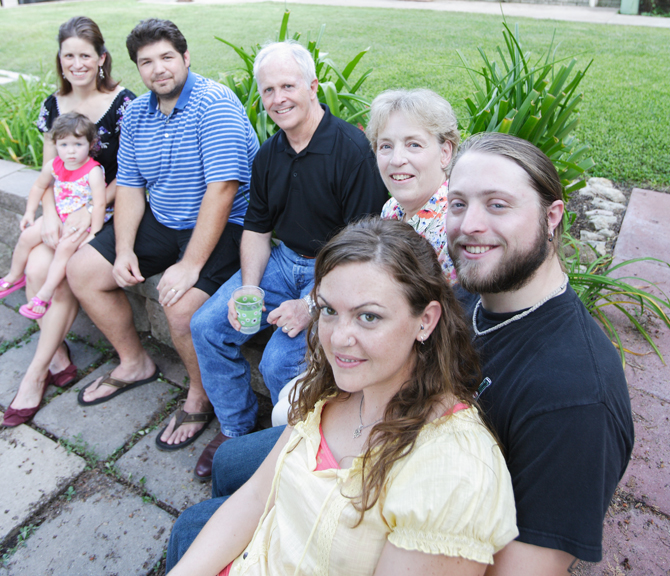 One tenant discovered, on a closet floor in his apartment, a small terra-cotta tile engraved with a black swastika. “I considered having some professionally religious friends perform an exorcism of sorts, then perhaps remove and ritually destroy the swastika,” he said, “but with my luck, I would probably get sued for damaging an historical landmark.” Instead, he covered it with a mat.
One tenant discovered, on a closet floor in his apartment, a small terra-cotta tile engraved with a black swastika. “I considered having some professionally religious friends perform an exorcism of sorts, then perhaps remove and ritually destroy the swastika,” he said, “but with my luck, I would probably get sued for damaging an historical landmark.” Instead, he covered it with a mat.
The Stahls set about repairing the neglected complex, raising their three children, and tending to the tenants who became an extended family. It was the Stahls who really built a community around their courtyard. Eventually, they obtained city landmark status for the Dorothy Lane.
“Papa” Frank Delgado, resident gardener and groundskeeper, was family. Former Fort Worth Star-Telegram reporter Wayne Anderson remembered how Frank regularly clipped roses from the courtyard garden and put them on a small altar to the Virgin Mary and his mother, inside his quarters. When Papa Frank died, he was eulogized in the apartment newsletter.
Former tenant Ron Green called the place a cultural vortex. “I remember being fascinated, almost overwhelmed, by the architecture of the place … and the interesting group of residents,” recalled Green, a musician and teacher now living in Oregon.
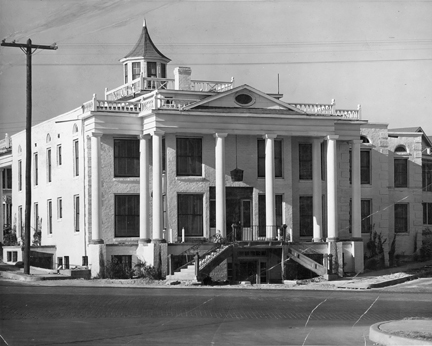 The Texas College of Osteopathic Medicine and its successor, the University of North Texas Health Science Center combined with the Stahls’ welcoming manner to bring a bit more diversity to the neighborhood. “Someone once suggested we should hang flags of various countries from the buildings,” Ann recalled. Herbert Oye from Nigeria, now a vascular surgeon in Beckley, W. Va., lived at the Dorothy Lane in the 1980s. Abdul Itani’s Lebanese family came to spend the winter holiday with him one year.
The Texas College of Osteopathic Medicine and its successor, the University of North Texas Health Science Center combined with the Stahls’ welcoming manner to bring a bit more diversity to the neighborhood. “Someone once suggested we should hang flags of various countries from the buildings,” Ann recalled. Herbert Oye from Nigeria, now a vascular surgeon in Beckley, W. Va., lived at the Dorothy Lane in the 1980s. Abdul Itani’s Lebanese family came to spend the winter holiday with him one year.
For Stacy Schoolfield, the Dorothy Lane “was the first place I felt at home in all by myself.” The Stahls, she said, “never felt like landlords; they were friends. That is rare, as I’ve since learned.
“I remember the people,” Schoolfield wrote in an e-mail. The documentary filmmaker and journalist, now studying at the University of Denver, came to the Dorothy Lane just after college and a year abroad in Wales. “The man who lived below me … rarely spoke, but when I needed quarters for laundry [he] was always happy to provide them, as long as they weren’t part of his state quarters collection.
“While I was there in the tiny efficiency, three British friends came and stayed about six weeks with me. I don’t know how we managed it, but it never seemed too small to us.”
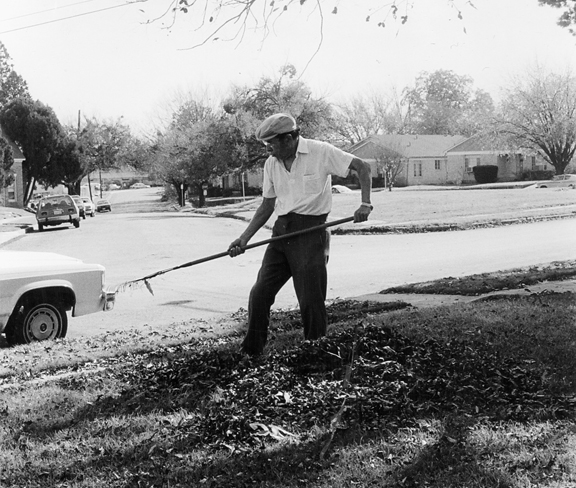 Journalist Carol Mazzocca edited the El Atrio newsletter for residents, a project encouraged and funded by the Stahls. Mazzocca’s future husband, Mark Sennott, also on the Star-Telegram staff, and others contributed articles, sketches, and photographs. As a result, the late 1980s are the best-documented era at the Dorothy Lane.
Journalist Carol Mazzocca edited the El Atrio newsletter for residents, a project encouraged and funded by the Stahls. Mazzocca’s future husband, Mark Sennott, also on the Star-Telegram staff, and others contributed articles, sketches, and photographs. As a result, the late 1980s are the best-documented era at the Dorothy Lane.
Free-spirited influences persisted. Anderson, who lived there in the mid-1980s, remembered the pool as an adult-swim venue in the wee hours — and hoped the Stahls slept through the bacchanalia.
Marti Sullivan has lived at the Dorothy Lane for 20 years. For about 10 of those years, Larry, the iguana, called her kitchen home, growing to a full four feet in length. The Stahls babysat Larry for several Christmases and once rescued him from the courtyard’s wishing well. Sullivan, a former Southwestern Baptist Theological Seminary student, changed career paths and joined the faculty of North Hi-Mount Elementary School, where the Stahls are longtime supporters. To commute, she walks across Modlin Avenue.
Margaret Allyson, an author, editor, and fabric artist (and proofreader at Fort Worth Weekly) learned of the Dorothy Lane through friends. She lived there in 1991 and 1992.
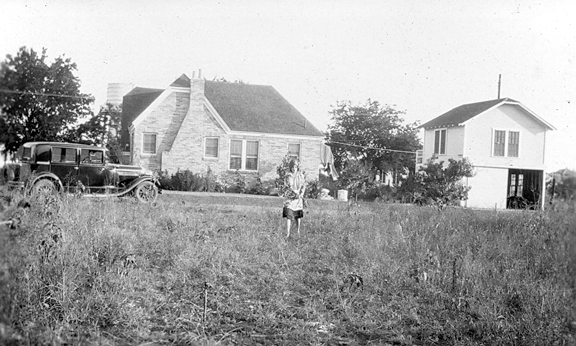 At first, she occupied a newer unit, but had her eye on an older ground-level apartment near “the pool, a fig tree, and an herb garden,” she said. “Just tell me if anybody died there,” she recalled telling Ann. “Somebody had, but it was right after he had returned from a nice vacation, so it didn’t seem ominous.”
At first, she occupied a newer unit, but had her eye on an older ground-level apartment near “the pool, a fig tree, and an herb garden,” she said. “Just tell me if anybody died there,” she recalled telling Ann. “Somebody had, but it was right after he had returned from a nice vacation, so it didn’t seem ominous.”
Ghosts? “Yes, there were ghosts in my second apartment, but I only saw them the first night I slept there,” Allyson said. “They seemed to just be checking out the new arrival.”
Her fellow tenants were a big part of the attraction. “Upstairs was a poet; next door was a nun spending a year out of the convent,” she recalled. “I loved living at the Dorothy Lane. I’d probably still be there, but I got to wanting a dog and a veggie garden.”
Present-day residents carry on the sense of community. One man, perhaps in the rumored spirit of the Slaughters, brews his own wheat beer and shares it with friends.
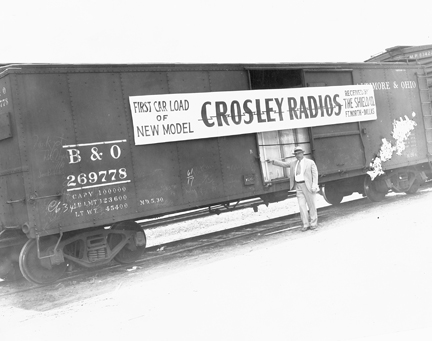 Musician, musical historian, and decorative painter William L. Williams of San Francisco was looking for a place to live while working on a project in Fort Worth. He noticed one day that someone had cleared away the vines climbing the archway along Bertrose, revealing the words “Dorothy Lane.” His mother’s name was Dorothy — but sentiment wasn’t the only thing that drew him to the place.
Musician, musical historian, and decorative painter William L. Williams of San Francisco was looking for a place to live while working on a project in Fort Worth. He noticed one day that someone had cleared away the vines climbing the archway along Bertrose, revealing the words “Dorothy Lane.” His mother’s name was Dorothy — but sentiment wasn’t the only thing that drew him to the place.
“I was attracted by the European charm … with people walking their dogs, jogging, strolling about in the evenings. It has a nice, neighborhood feel to it,” he said. Plenty of folks seem to feel the same: There’s always a waiting list of would-be tenants.
Brian Samuel, a young Realtor, is a newcomer. He’s curious about the apartments’ history and the connection to Carlin and Burns. But, he said, “I plan to make my own history here.”
Juliet George’s book, Fort Worth’s Arlington Heights is due out Aug. 9 from Arcadia Publishing. She and Sabine Renz are collaborating on a history of the Slaughters’ lives and properties.
{gallery}7212010{/gallery}











What an awesome read! I have always been interested in Texas history, even more so than in my home state of OK. Texas records always seemed to be better kept. That is, until I began the search for my husband’s birth parents. It breaks my heart to know that records at Homestead, that may have begun in the 1940’s, were destroyed. I hope time allows you to continue the preservation of this colorful history.
Oh, and George Carlin, was one of my favorites. His perspective on life fascinated me.
And Crosley radios…..one day while at my antique shop a gentleman pulled up and said I have something in my trunk you might be interested in buying (probably 1995) and I couldn’t believe my eyes when he opened the trunk and there lay two bakelite Crosley radios in perfect condition. I am still kicking myself for selling them.
Thank you so much for your contribution!
Donna Mayhar
Hi! I don’t suppose you’ve had any luck finding your husband’s birth parents? My mother was at Homestead in 1966, and has been looking since she was 18.
Contact me I can give you information that may help.
I was adopted from Homestead also and have found my parents.
This article is a little jewel and we could use more such recollections of Fort Worth’s bygone days. Seems we have been neglectful in the recording of so many things and people of this area… but I digress. Yes, this is a wonderful bit of local history!!! Thank you for completing an inspiration begun many years back. I was born and raised in Fort Worth but left in the early 1969 to end up in the art colony of the New Orleans French Quarter. After many fine years of painting and enjoying the creative life there this homesick guy returned home. Years before, as a young teenager I would ride a bike over to the Amon Carter Museum, which was fascinating and motivational, with their amazing wealth of art. In doing so I passed this neighborhood compound of charming apartments and wondered what tales they could tell. Those unusual buildings still draws me out of the way when in that area. The unconventional, imaginative, creative spirit of some of Cowtown’s residents past & present comprise a true treasure. Fall is a busy time in the studio, filling New Orleans gallery orders and area shows , but time will be carved out to allow some fun sketching of the Dorothy Lane’s tiny village. Thanks again for this delightful bit of history.
I would like to see the rest of Pearl Slaughter’s life story. I really wonder how she became one of the founders, running Homestead, and selling babies. I also think that Homestead was run and directed by many “different” characters and players. I have heard stories of outside housing for unwed birth mothers. I wonder how many girls stayed at this place, but Homestead was used as the adoption agency.
I would really love to know the inside secrets of when this agency actually started, operated, and what they really did. So many secrets. So many people effected, so many questions…..and so few answers. Boy, if those walls could talk.
Mind blown! Just read this wonderful insightful article about a place I drove by for years and sat at the Clark stoplight watching and wondering about that “place” my parents told me to ignore and just keep facing forward when I was near! My parents built their west side home on the east corner of Thomas Pkace and Clark in 1956. It was my home too through my years at Heights and TCU. They continued to live there until they sold 30 years later in ‘86. Through the years I lived and traveled up and down Clark I always wondered about the goings on there because my parents were always so hush-hush whenever I would ask about it! I always admired the “hotel” and knew it had some tainted reputation just by their actions. Thanks for this wonderful information! I look forward to your upcoming Arcadia book!
I was married to Wyatt William Slaughter. He passed away May 2, 2002 leaving our daughter Lindsay Cherie’ Slaughter. I have read the article before but love to visit it again and again occasionally.